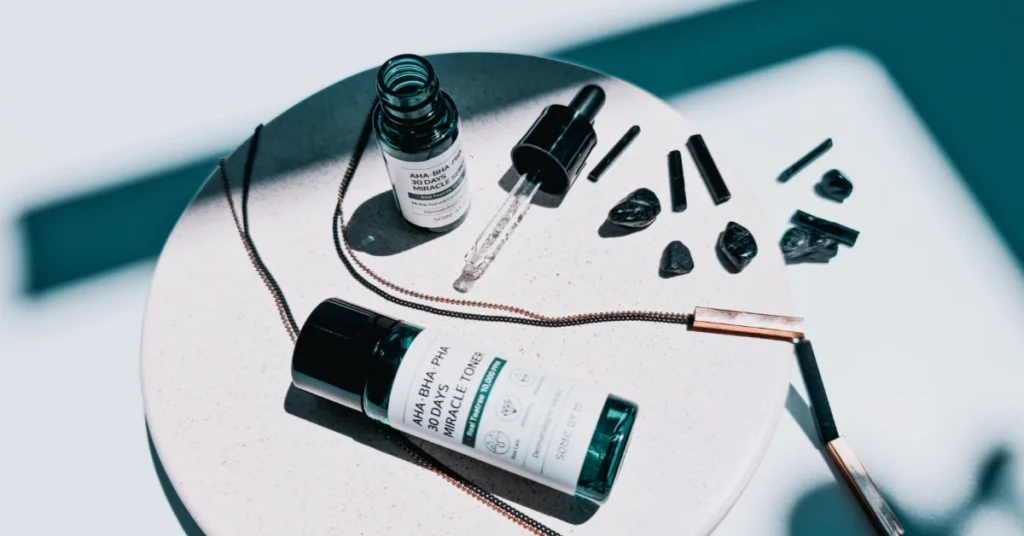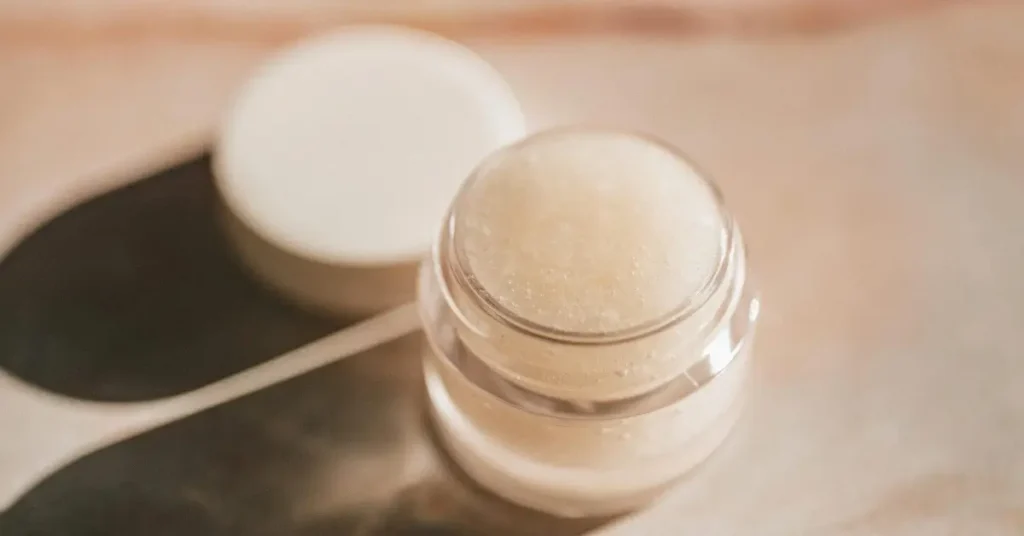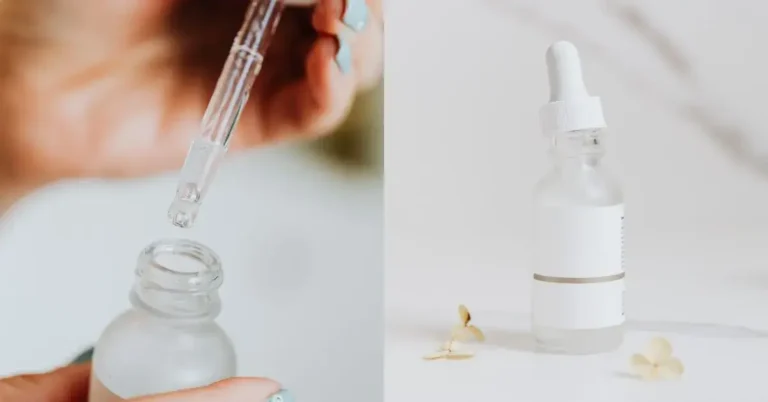Are you struggling with ongoing skin problems and in search of a revolutionary fix? Search no more! In this article, we explore the fascinating world of skincare to tackle the essential query: Is it safe to combine Salicylic Acid and Tretinoin?
As someone who has personally experienced the remarkable benefits of this powerful duo, I’m here to share my insights and guide you toward a clearer, more radiant complexion. Join me as we explore the science, benefits, and precautions of using Salicylic Acid and Tretinoin together.
Table of Contents
Can I Use Salicylic Acid and Tretinoin Together?
As you might know, salicylic acid is a beta hydroxy acid (BHA) known for its exfoliating properties and effectiveness in treating acne-prone skin. It works by dissolving the debris and dead skin cells, unclogging pores, and reducing inflammation.
On the other hand, tretinoin is a potent form of vitamin A, available only through prescription, and it works by increasing the cell turnover rate of your skin. This rapid exfoliation results in a more youthful appearance, smoother texture, and reduced acne.
Now, you may be tempted to combine these powerful ingredients to supercharge your skincare routine. However, it’s essential to be cautious and understand their potential interactions.
Using a salicylic acid cleanser with tretinoin at the same time may not be ideal, as both are potent exfoliants and can potentially cause skin irritation. It’s always best to consult with a dermatologist or skincare expert to create a personalized routine that addresses your unique skin concerns.
Mechanism of Action

Ever wondered how niacinamide and salicylic acid work their magic on your skin? You’re not alone! In this section, we’ll dive into the mechanism of action for two popular skincare ingredients: Salicylic Acid and Tretinoin, both of which have helped countless individuals, including me, achieve clearer, smoother, and healthier skin.
Salicylic acid is a superstar when it comes to tackling acne and other skin issues. Its primary function involves the irreversible inhibition of COX-1 and COX-2 enzymes, which in turn decreases the conversion of arachidonic acid to precursors of prostaglandins and thromboxanes. This process ultimately gives salicylic acid its analgesic and anti-inflammatory properties, making it a key component in many skincare products.
Now, let’s talk about Tretinoin. As a retinoid, Tretinoin increases skin cell turnover. It encourages the production of new skin cells and speeds up their journey to the surface of your skin. This helps to shed dead skin cells more effectively, making way for a smoother and fresher complexion.
Although the exact mechanism of action for Tretinoin in skin conditions hasn’t been entirely elucidated, it’s clear that this powerful ingredient can make a remarkable impact on improving acne and overall skin health.
Interestingly enough, both salicylic acid and retinol can increase your skin cell turnover, albeit in different ways. Combining these two ingredients in your skincare routine can potentially offer amplified benefits. However, it’s crucial to pay attention to your skin’s needs and reactions when introducing new products, especially those containing active ingredients like tretinoin and salicylic acid.
Benefits and Uses

Have you ever wondered if combining salicylic acid with tretinoin could revolutionize your skincare routine? Well, you’re in for a treat! This combination may bring about outstanding benefits to your skin, addressing several concerns. Let’s dive into the key uses of salicylic acid and tretinoin.
Acne Treatment
Both salicylic acid and tretinoin can work wonders in treating acne. Salicylic acid helps to unclog pores by breaking down dead skin cells, while tretinoin promotes skin cell turnover and renewal. Incorporating these ingredients in your skincare routine can significantly reduce acne breakouts and improve overall skin health.
Anti-Aging
One of the fabulous things about tretinoin is that it has powerful anti-aging properties. When used consistently, it can boost collagen production, reduce sun damage, and even improve the appearance of wrinkles. Combining it with other effective ingredients, like salicylic acid, can enhance its ability to keep your skin looking youthful and vibrant.
Skin Texture Improvement
Aside from treating acne and fighting the signs of aging, this dynamic duo can also contribute to a more even skin texture. Tretinoin and azelaic acid are often used together to address skin concerns like hyperpigmentation and uneven texture. These ingredients work to brighten and smooth your skin, leaving you with a more radiant complexion.
So, if you want to give your skin the tender love and care it deserves, trying out a combination of tretinoin and salicylic acid might just be what you need. Just remember to consult your dermatologist for advice on which products and concentrations are best suited for your skin type.
Side Effects and Precautions

Dryness and Irritation
Both Salicylic Acid and Tretinoin possess strong properties that might cause dryness and irritation for your skin, especially during the initial weeks of use. To alleviate discomfort, I recommend you apply a moisturizer after using these products, and introduce them gradually into your regimen, allowing your skin to adjust.
Sun Sensitivity
Another concern with these ingredients is increased sun sensitivity due to the exfoliating properties of Salicylic Acid and Tretinoin. To protect your skin, always wear sunscreen with an SPF of 30 or higher, and avoid excessive sun exposure during peak hours.
Pregnancy and Breastfeeding
Attention, all pregnant or breastfeeding moms! The safety of using Tretinoin during pregnancy or breastfeeding is not well-established, and it’s recommended to consult your healthcare provider before using it. On the other hand, Salicylic Acid is considered safe in small amounts during pregnancy, but it’s always a good idea to double-check with your doctor.
Be mindful of these precautions and potential side effects, and keep an open line of communication with your healthcare professional. Armed with this knowledge, you’re on your way to achieving healthier, clearer skin!
Dosage and Application
Frequency
For tretinoin, I generally recommend you apply a pea-sized amount to the affected area once a day, at bedtime. Meanwhile, salicylic acid can be used in various frequencies, depending on the strength and formulation. Some topical salicylic acid products, such as 16.7% liquid, can be applied to warts 1 to 2 times daily. On the other hand, a 3% salicylic acid soap may be used at least twice weekly for effective results.
Formulations
Both salicylic acid and tretinoin are available in a wide range of formulations, including creams, gels, liquids, and lotions. The proper use for each formulation may vary:
- Tretinoin cream, gel, or liquid: Adults should apply a pea-sized amount to the affected area once a day, at bedtime. Children’s use and dosage must be determined by a doctor.
- Tretinoin lotion: Adults and children aged 9 years and older should apply a thin layer to the affected area(s) once a day.
- Salicylic acid 6% cream: Apply a thin layer to the affected area once daily.
Remember that it is important not to use a salicylic acid cleanser with tretinoin at the same time, as both ingredients are potent and can lead to skin irritation if used together. Consult with a dermatologist to determine the most suitable formulations for your skin type and condition.
Comparing Salicylic Acid and Tretinoin
Effectiveness

When it comes to treating acne and blemishes, both tretinoin and salicylic acid are top contenders. However, their modes of action differ. Salicylic acid, a beta hydroxy acid (BHA), is renowned for its exfoliating properties. It can penetrate and unclog pores, thereby reducing breakouts and blackheads. It’s also ideal for targeting acne, inflammation, and uneven skin texture.
On the other hand, tretinoin is a retinoid, meaning it is derived from vitamin A. It helps boost skin cell turnover, resulting in smoother, clearer skin. Tretinoin is a powerhouse when it comes to tackling acne and even promoting collagen production, ultimately addressing fine lines and wrinkles.
Side Effects
While both salicylic acid and tretinoin come with their share of benefits, they might cause some side effects. Salicylic acid, though generally well-tolerated, might lead to skin dryness, itching, or redness, particularly if your skin is sensitive. Patch test a product in a small area before using it on your entire face.
In the case of tretinoin, it’s essential to be cautious as its side effects can be more pronounced. You might experience dryness, skin peeling, or redness, especially during the initial phase of use. Be patient and gradually increase its usage to avoid triggering irritation.
FAQ:

What is better for acne salicylic acid or tretinoin?
Tretinoin is more effective for acne than salicylic acid due to its ability to unclog pores, reduce inflammation, and promote cell turnover.
How can I make tretinoin more effective?
To enhance the effectiveness of tretinoin, use it as directed by a dermatologist, apply a pea-sized amount to clean, dry skin, gradually increase frequency of use, use a gentle cleanser and moisturizer, and protect skin from sun exposure with SPF.
Is it OK to use salicylic acid everyday?
Using salicylic acid daily is generally safe for most people, but it’s important to monitor your skin’s response. If you experience excessive dryness, irritation, or redness, reduce the frequency of use or consult a dermatologist for personalized advice.
What happens if you stop using tretinoin?
If you stop using tretinoin, the improvements it made to your skin, such as reduced acne and smoother texture, may gradually reverse, and your skin may return to its previous condition.
When should I stop using salicylic acid on my face?
You should stop using salicylic acid on your face if you experience excessive dryness, irritation, or redness that doesn’t improve with time. It’s important to listen to your skin’s response and discontinue use if it becomes too harsh or uncomfortable.
If you liked this blog post about the question: Can I use Salicylic Acid with Tretinoin, don’t forget to leave us a comment down below to tell us about your experience with it.





